Windows Live Mesh
 | |
 Windows Live Mesh | |
| Developer(s) | Microsoft |
|---|---|
| Final release | 2011 (15.4.3555.0308 Win, 15.4.5726.23 Mac)
/ March 22, 2012 |
| Operating system | Windows(XP and later) andMac OS X (Intel Only) |
| Type | File sharing |
| Website | Archived official websiteat theWayback Machine(archive index) |
Windows Live Mesh(formerly known asWindows Live FolderShare,Live Mesh,andWindows Live Sync) is a discontinued free-to-use Internet-basedfile synchronizationapplication byMicrosoftdesigned to allow files and folders between two or more computers to be in sync with each other onWindows(Vista and later) andMac OS X(v. 10.5 Leopard and later, Intel processors only) computers or the Web viaSkyDrive.[1]Windows Live Mesh also enabled remote desktop access via the Internet.
Windows Live Mesh was part of the Windows Live Essentials 2011 suite of software. However this application was replaced by SkyDrive for Windows application inWindows Essentials2012 and laterOneDrivein Windows 8/8.1/10. Microsoft announced on December 13, 2012, that Windows Live Mesh would be discontinued on February 13, 2013.[2]
Features[edit]
Features of Windows Live Mesh include:
- Ability to sync up to 200 folders with 100,000 files each (each file up to 40GB)[3]for PC-to-PC synchronization
- Ability to sync up to 5GBof files to "SkyDrive synced storage" in the cloud
- Remote Desktop access via Windows Live Mesh and theWindows Live Devicesweb service
- PC-to-PC synchronisation of application settings for applications such as:
- Windows Internet Explorer- synchronisation of favorites and recently typed URLs between computers
- Microsoft Office- synchronisation of dictionaries,Outlookemail signatures, styles and templates between computers
History[edit]
[edit]
Microsoft bought FolderShare from ByteTaxi Inc. on November 3, 2005, and subsequently made it a part of theirWindows Liverange of services.[4]
On March 10, 2008, Microsoft released its first user visible update to the then Windows Live FolderShare. This comprised a rewrite of the FolderShare website and an updated Windows Live FolderShare client. Support for discussion groups and Remote Desktop Search was also removed in the update. The new client had some user interface and branding updates and contained several bug fixes - including official support forWindows Vistaand discontinued support forWindows 2000.
Since its rebrand as Windows Live FolderShare, the client and service had undergone extensive platform changes, switching from the originalLAMPwhich it was originally built on when acquired, to theWindows Serverplatform. In the Windows Live Essentials "Wave 3" release, Windows Live FolderShare was again rebranded as Windows Live Sync. New UI improvements were also announced to be part of the "Wave 3" release, integrating it with other Windows Live services. New features of the then Windows Live Sync "Wave 3" compared to FolderShare included increased limit of sync folders, integration withWindows Live ID,integration with Recycle Bin, unicode support, support forMac OS X,and integration withWindows Live Photo GalleryandWindows Live Toolbarto sync photo albums and favorites between PCs.[5]Windows Live Sync Wave 3 was released on December 11, 2008,[6]and an update of Windows Live Sync for Mac was released on November 2, 2009, to add support forMac OS X10.6.[7]
Live Mesh Beta[edit]

Microsoft released the Live Mesh technology preview on April 23, 2008, adata synchronizationsystem that allowed files, folders and other data to be shared and synchronized across multiple personal devices and up to 5 GB on the web.[8]Live Mesh was based onFeedSynctechnologies to convey the changes made in each device so that the changes can be synchronized across all devices and the cloud.[9]The information about devices and folders participating in a synchronization relationship was not stored locally but at the service-end.[10]

The Live Mesh software, calledMesh Operating Environment(MOE),[11]was available forWindows XP,Windows Vista,Windows 7,Mac OS X,as well asWindows Mobile6.[12]It could be used to create and manage the synchronization relationships between devices and data. Live Mesh also included acloud storagecomponent, calledLive Desktop,which was an online storage service that allows synchronized folders to be accessible via a website.[8]Live Mesh also provided aremote desktopsoftware calledLive Mesh Remote Desktopthat could be used to remotely connect to and manage any of the devices in a synchronization relationship.[11]Live Mesh Remote Desktop allowed users to control their devices from the Live Mesh application, as well as from any other internet connected PC.
Live Mesh also included a developer component, which consisted of a set ofprotocolsandApplication Programming Interfaces(API) known asLive Framework(which was also briefly known asMeshFX).[13]It was aREST-based API for accessing the Live Mesh services overHTTP.Microsoft had also providedAPIsformanaged code(including.NET FrameworkandMicrosoft Silverlight) as well as forWin32andJavaScriptvia a developerSoftware Development Kit(SDK).[13]Unlike the Mesh Operating Environment (MOE), which was limited to sharing folders, the Live Framework APIs could be used to share any data item between devices that recognize the data.[10]The API encapsulated the data into aMesh Object—the native synchronization unit of Live Mesh—which was then tracked for changes and synchronized. A Mesh Object consisted of a collection of Data Feeds, which could be represented inAtom,RSS,JSONorPlain Old XMLformats. The data entries within these feeds were synchronized via theFeedSyncprotocol. The MOE software also created Mesh Objects for each Live Mesh folder in order for them to be synchronized.[10]However, the Live Framework APIs were discontinued on September 8, 2010, with the aim of being integrated intoWindows Live Messenger Connectin the "Wave 4" release.[14]Live Mesh beta was officially discontinued on March 31, 2011.[15]
Windows Live Mesh 2011[edit]
A beta version Windows Live Sync "Wave 4" was released on June 24, 2010. This new version, while initially branded Windows Live Sync, was the first version which was built using both FolderShare and Live Mesh technologies. Compared to the "Wave 3" version of Windows Live Sync, the new version featured increased limit of sync folders and files, ability to sync up to 2 GB of files to the cloud onWindows Live SkyDrivesynced storage, addition of Live Mesh's remote desktop access viaWindows Live Devices,and ability to sync application settings for Internet Explorer and Microsoft Office. This new version of Windows Live Sync was also designed to be completely separate from both the previous versions of Windows Live Sync and Live Mesh, and as such any previous synchronisation relationships were not retained when being upgraded from Windows Live Sync "Wave 3" and Live Mesh. The previous Windows Live Sync "Wave 3" website, and the Live Mesh Desktop, was also replaced by the newWindows Live Devicesservice in the "Wave 4" release.
The beta was subsequently updated on August 17, 2010, and on August 29, 2010, the service was officially rebranded as Windows Live Mesh, and its cloud-based SkyDrive synced storage was increased to 5GB,as was the case for the previous Live Mesh service. The new version also allows users to sync hidden files, view a list of missing files that are awaiting to be synchronised, and various performance improvements.[16]The final version of Windows Live Mesh 2011 (Wave 4) was released on September 30, 2010, as part ofWindows Live Essentials 2011.
SkyDrive[edit]
Microsoft announced on February 20, 2012, that Windows Live Mesh is set to be superseded by a newSkyDrivedesktop application, where the cloud storage portion for the application will utilize the full 7 GBSkyDrivestorage (or more if the user has purchased additional storage), rather than the limited 5 GB "SkyDrive synced storage" in the current version of Windows Live Mesh. However, the new SkyDrive desktop application will not support direct PC-to-PC synchronization, and must utilize the SkyDrive cloud storage for synchronization between two or more devices.[17][18]On August 7, 2012, Microsoft releasedWindows Essentials2012, where it was announced that Windows Live Mesh would be removed and replaced by theSkyDrivefor Windows desktop application if a user upgrades from Windows Live Essentials 2011.[19]
The Remote Desktop feature from Live Mesh, which allowed users to access the remote computer from the web browser, is not transferred to Skydrive. Users are directed to useRemote Desktopfrom a Windows computer instead.
Windows Live Mesh was discontinued on February 13, 2013, and some of the functionality is replaced by SkyDrive.[2]
On January 27, 2014, Microsoft announced the rebranding of SkyDrive to "OneDrive".[20]
References[edit]
- ^"Live Sync 2011: Improved! With Less Storage!".LiveSide.2010-06-03. Archived fromthe originalon 2010-06-06.Retrieved2010-06-03.
- ^abKornfield, David (13 December 2012)."Update on Windows Live Mesh".Inside Skydrive.Microsoft.Archived fromthe originalon 16 December 2012.Retrieved1 January2013.
- ^"Windows Live Sync beta blends the best of Sync and Mesh".Microsoft.Archived fromthe originalon 4 February 2012.
We also increased key sync limits, with support for more sync folders, many more files in each folder, and the ability to synchronize files as large as 40GB now.
- ^"FolderShare - File Transfer & Remote File Access".Foldershare.Archived fromthe originalon July 5, 2007.Retrieved2013-06-15.
- ^"FolderShare team blog: Windows Live Sync replacing FolderShare: What you need to know".FolderShare.2008-11-19.[dead link]
- ^LeBranc, Brandon."The Windows Blog: Windows Live Sync to replace Windows Live FolderShare".Windows Experience Blog.Microsoft.Archived fromthe originalon December 6, 2008.
- ^"Windows Live Sync Team Blog: Windows Live Sync: now on Snow Leopard".Windows Live Sync Team Blog.Microsoft.Archived fromthe originalon December 26, 2009.
- ^ab"Live Mesh: it's everything we told you about (and a lot more)".LiveSide.2008-04-23. Archived fromthe originalon 2008-04-24.
- ^"Ray Ozzie on Live Mesh:" There's almost nothing there "".LiveSide.2008-04-23. Archived fromthe originalon 2008-05-02.
- ^abcMike Zintel (2008-04-22)."Live Mesh: Live Mesh as a platform".Live Mesh.Microsoft.Retrieved2008-08-24.
- ^abMary Jo Foley (2008-04-22)."Ten things to know about Microsoft's Live Mesh".ZDNet.CBS Interactive.Archived fromthe originalon 2008-04-30.Retrieved2008-04-23.
- ^"Service update: Beta and required client upgrade".Live Mesh.Microsoft.2008-10-30.
- ^ab"Web 2.0: Microsoft Makes Big Bet For 'Software Plus Services' With Live Mesh".InformationWeek. 2008-04-23. Archived fromthe originalon 2008-04-27.Retrieved2008-04-28.
- ^"Live Framework CTP to shut down September 8th".LiveSide.August 21, 2009. Archived fromthe originalon August 26, 2009.
- ^"Windows Live Mesh and Devices Help Center".Live.Microsoft.Archived fromthe originalon March 18, 2012.
On March 31, 2011, the Live Mesh beta software will stop working, and www.mesh.com will be shut down. After March 31, you won't be able to access any files stored online in your Live Desktop or connect to your PCs remotely using the Live Mesh software. Microsoft will not be able to help you retrieve any files you have stored online after this date. Your files will also stop syncing between your computers and your Live Mesh online storage.
- ^"Windows Live Sync to be named Windows Live Mesh".Inside Windows Live.Microsoft.Archived fromthe originalon August 29, 2010.
- ^"Connecting your apps, files, PCs and devices to the cloud with SkyDrive and Windows 8".Building Windows 8.Microsoft.2012-02-20.
- ^"No PC to PC sync in new SkyDrive".LiveSide.23 February 2012.
- ^Foley, Mary Jo."Microsoft Live Mesh users: Read the Windows Essentials 2012 fine print".ZDNet.Retrieved2018-03-30.
- ^Paul, Ian (January 27, 2014)."Microsoft renames SkyDrive to OneDrive".PC World.IDG.RetrievedAugust 27,2015.
External links[edit]
- Official website(Archive)


